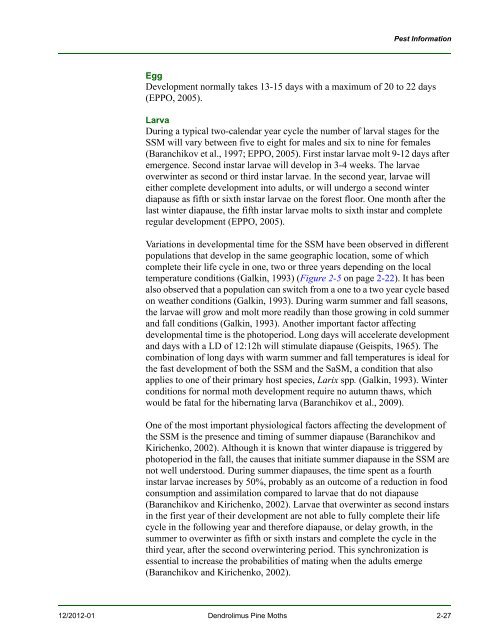New Pest Response Guidelines - aphis - US Department of Agriculture
New Pest Response Guidelines - aphis - US Department of Agriculture
New Pest Response Guidelines - aphis - US Department of Agriculture
You also want an ePaper? Increase the reach of your titles
YUMPU automatically turns print PDFs into web optimized ePapers that Google loves.
<strong>Pest</strong> Information<br />
Egg<br />
Development normally takes 13-15 days with a maximum <strong>of</strong> 20 to 22 days<br />
(EPPO, 2005).<br />
Larva<br />
During a typical two-calendar year cycle the number <strong>of</strong> larval stages for the<br />
SSM will vary between five to eight for males and six to nine for females<br />
(Baranchikov et al., 1997; EPPO, 2005). First instar larvae molt 9-12 days after<br />
emergence. Second instar larvae will develop in 3-4 weeks. The larvae<br />
overwinter as second or third instar larvae. In the second year, larvae will<br />
either complete development into adults, or will undergo a second winter<br />
diapause as fifth or sixth instar larvae on the forest floor. One month after the<br />
last winter diapause, the fifth instar larvae molts to sixth instar and complete<br />
regular development (EPPO, 2005).<br />
Variations in developmental time for the SSM have been observed in different<br />
populations that develop in the same geographic location, some <strong>of</strong> which<br />
complete their life cycle in one, two or three years depending on the local<br />
temperature conditions (Galkin, 1993) (Figure 2-5 on page 2-22). It has been<br />
also observed that a population can switch from a one to a two year cycle based<br />
on weather conditions (Galkin, 1993). During warm summer and fall seasons,<br />
the larvae will grow and molt more readily than those growing in cold summer<br />
and fall conditions (Galkin, 1993). Another important factor affecting<br />
developmental time is the photoperiod. Long days will accelerate development<br />
and days with a LD <strong>of</strong> 12:12h will stimulate diapause (Geispits, 1965). The<br />
combination <strong>of</strong> long days with warm summer and fall temperatures is ideal for<br />
the fast development <strong>of</strong> both the SSM and the SaSM, a condition that also<br />
applies to one <strong>of</strong> their primary host species, Larix spp. (Galkin, 1993). Winter<br />
conditions for normal moth development require no autumn thaws, which<br />
would be fatal for the hibernating larva (Baranchikov et al., 2009).<br />
One <strong>of</strong> the most important physiological factors affecting the development <strong>of</strong><br />
the SSM is the presence and timing <strong>of</strong> summer diapause (Baranchikov and<br />
Kirichenko, 2002). Although it is known that winter diapause is triggered by<br />
photoperiod in the fall, the causes that initiate summer diapause in the SSM are<br />
not well understood. During summer diapauses, the time spent as a fourth<br />
instar larvae increases by 50%, probably as an outcome <strong>of</strong> a reduction in food<br />
consumption and assimilation compared to larvae that do not diapause<br />
(Baranchikov and Kirichenko, 2002). Larvae that overwinter as second instars<br />
in the first year <strong>of</strong> their development are not able to fully complete their life<br />
cycle in the following year and therefore diapause, or delay growth, in the<br />
summer to overwinter as fifth or sixth instars and complete the cycle in the<br />
third year, after the second overwintering period. This synchronization is<br />
essential to increase the probabilities <strong>of</strong> mating when the adults emerge<br />
(Baranchikov and Kirichenko, 2002).<br />
12/2012-01 Dendrolimus Pine Moths 2-27

















